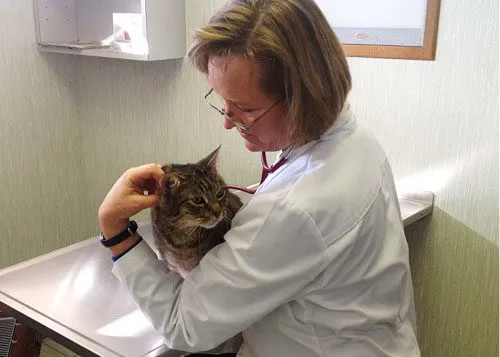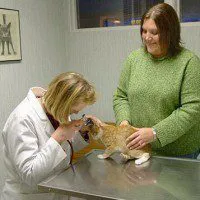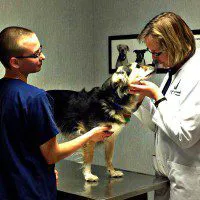!Request Appointment Button
!Header Buttons Right Side
What Can I Expect During my Pets Preventative Care Examination
You will be asked about any health issues or concerns about your pets. Preventative care exams and discussions will be tailored to the life stage and lifestyle of your dog and cat.
We will frequently have you fill out a wellness questionnaire to help you access your pet’s health behavior at home. If your pet is a senior pet 8 years of age and over we have a more detailed senior health questionnaire. Don’t forget to mention any unusual behavior that you have noticed in your pet, including:
- Coughing
- Diarrhea
- Eating more than usual
- Excessive drinking of water, panting, scratching or urination
- Vomiting
- Weight gain or weight loss
- Lameness or evidence of slowing down
- Diet changes and what your pet is eating
- Is your pet inside or out and what is their exposure to other animals
- Parasite testing and control will be discussed including exposure to fleas, ticks, heartworms and intestinal parasites. A preventative program will be discussed.
Vital Statistics
At the beginning of the exam a veterinary technician or assistant will take your pet’s vital signs similar to when you go in for a physical exam. This will include taking your pet’s temperature, pulse or heart rate, respiration (breathing) rate and body weight. Monitoring the weight is an important part of maintaining your pet’s health. Changes in weight especially a weight loss since his last exam may be an indication of a developing metabolic disease such as diabetes or kidney disease. Weight gain can also be a significant problem and not only increases stress on the joints but increases the risk for metabolic diseases such as diabetes and liver disease. We can work with you to develop a diet plan and exercise plan to help return your pet to a healthier weight.
Ears
We will exam your pet’s ears and ask if you have noticed any problems. Otoscopes allow us to have a look farther into the ear canal to check for evidence of infection, growths or parasites.
Eyes
Eye are often felt to be the windows into the body and examinations often reveal many health issues, including anemia, infections, glaucoma, cataracts, high blood pressure, jaundice, kidney problems and allergies, in addition to eye injuries and ulcers. We will be looking at the outside of the eyes and eyelids and into the eyes themselves.
Mouth
We will check the color of your pet’s gums and tongue while we are looking at the mouth, teeth and hard palate (roof of the mouth) the color of the gums and tongue may suggest poor circulation associated with a heart problem or a pale color may suggest some anemia. We will also be looking for evidence of the most common disease we see in dogs and cats, dental disease. Dental disease (link to dental) may be seen with tartar buildup, dental abnormalities, fractures, loose teeth, tumors, infection and other problems. We will discuss the importance of regular professional teeth cleaning and routine home dental care (link to dental care) to prevent periodontal disease. Periodontal disease can lead to bad breath, bone loss leading to loss of teeth and significant mouth pain.
Heart and Lungs
The veterinary technicians will often use a stethoscope to get your pet’s heart rate when recording vital signs at the beginning of the exam. The veterinarians will use a stethoscope to listen to your pet’s heart and lungs for early signs of heart and respiratory disease.
Reproductive Organs
We will check your pet’s reproductive system for swellings, discharges and growths in the mammary glands or breasts. If your pet has not been spayed or neutered we will talk about not only the benefits for pet population control but the many health reasons for spaying or neutering your pet. This includes greatly decreasing their risk to some forms of cancer.
Skin
Your pet’s skin is the largest organ and a good gauge of overall health. We will check your pet’s skin and hair for fleas, ticks, other external parasites, tumors and wounds, as well as signs of allergies, infection, warts and tumors.
From Head to Toe
We will examine your pet from the nose to the tail including palpating the abdomen and checking for evidence of masses, enlarged organs or areas of discomfort. This will help us detect problems in the stomach, kidneys, liver and intestines. We will also be checking for evidence of lymph node changes and check your pet’s legs, joints and paws. .
We may recommend additional testing to diagnose or verify a health problem if we finds any abnormalities during your pet’s examination.
Vaccination
Vaccinations are one of the most important preventive measures you can take for the health of your pet. We will update any vaccinations that are indicated only after a thorough physical examination to make sure that your pet is healthy. Core vaccinations are vaccinations that we routinely give to all of our dog patients. These include immunizations against Distemper, Hepatitis, Parainfluenza , Parvovirus (DHPP vaccinations), Rabies and Bordetella. Other vaccinations that we discuss for dogs depending on lifestyle and risk factors are Leptosporosis and Lyme disease. Our cat core vaccinations include Feline Panleukopenia (distemper), Feline Rhinotracheitis, Calicivirus (FVRCP), and Rabies. We will also discuss lifestyle and risk factors for the life threatening disease Feline Leukemia and appropriate vaccinations for that disease.
How frequently you should have your pet vaccinated against certain diseases depends on many factors, including age and lifestyle. We will be happy to discuss what is right for your cat or dog.
A routine preventative care examination is an extremely important part of helping maintain a healthy and happy pet. These regular examinations will help your dog or cat live a longer and healthier life.
Please contact us if you have any questions on wellness or preventative plans for your dog or cat. We look forward to seeing you for your pet’s appointment with us.




